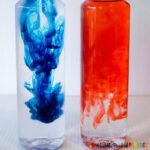Hot and Cold Temperature Science Experiments
We did 6 different science activities to learn about temperature and the difference between hot and cold. We have a free printable activity to go along with all the hands on activities so your little scientists can have fun understanding more about hot and cold.
Materials
- Voss Water bottle (or plastic bottle)
- Red and blue food coloring
- Thermometer
- Water balloons
- Ice Cube tray
- Glass measuring cups
Instructions
- Frozen Water
Fill containers half full with water. Mark the water line with a marker or I used a rubber band because we use our water bottles a lot. Put them in the freezer until they are completely frozen. Have children look at the new water lever (ice level). The frozen line should be above the water line because when water freezes it expands because the hydrogen bonds in the water that form are more spread out then when it is in liquid state.Red and Blue Food Coloring RaceFill one tall container with ice cold water and another tall container with hot water (not boiling). Have child drop a few drops of red food coloring in the hot bottle and blue food coloring in the cold water and watch (this experiment is very fast so don't look away). Technically you could use whatever color food coloring you have but since red and blue help to reinforce the difference in temperatures we used those colors. The blue food coloring should move slower through the water compared to the red food coloring because the water molecules in the hot water have more energy and move faster then the water molecules in the cold water.Blue Ice Melt
Fill a pitcher with water and add drops of blue food coloring. Fill an ice tray with the blue water and put it in the freezer until the ice is solid. Fill a container with room temperature water and place the blue ice inside. The ice should float and the blue water that melts from the ice cube should sink. This is because cold water (and air) is more dense compared to regular temperature water and will sink in warmer water. They may have heard before that hot air rises and cold air sinks, now they can visualize it.Hot & Cold BalloonsFill small balloons with some air. We used water balloons. Make them relatively the same size. Place one in cold water and one in hot water. We used a pink balloon for the hot water and the blue balloon for the cold water. The hot water balloon should get larger as the air expands as it gets warm and the cold water balloon should shrink as the air inside condenses.Thermometer Reading
After the balloon test we used our thermometer to measure the water temperatures and then we wrote the temperature on our Hot and Cold Molucule CraftHot and Cold Molecule Craft
Have children glue molecules in the hot and cold cups showing their understanding of hot and cold. The hot molecules should be spread out and moving around while the cold molecules should be condensed and slow moving. We used marshmallows. Available here: https://alittlepinchofperfect.com/learn-hot-cold-temperature-science-experiments-kids/
